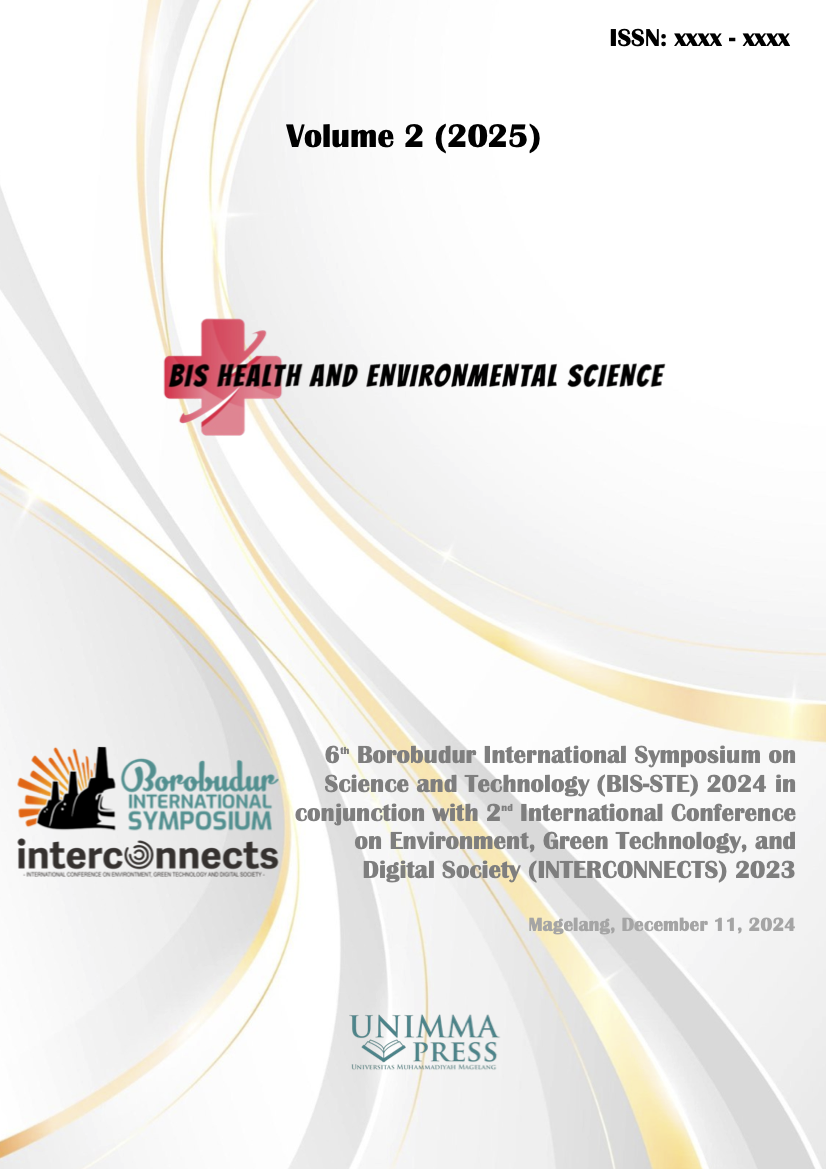The trends of physical and mental health as indicators of non-communicable diseases in families: A descriptive study
Keywords:
Early detection, Diabetes mellitus, Hypertension, Non-communicable diseasesAbstract
Physical discomfort due to chronic illness can occur in any individual. Especially non- communicable diseases, these chronic diseases occur due to lifestyle factors in the family, genetics, and aging. Non-communicable diseases can be prevented with early detection and prevention efforts. The purpose of this study is to see an overview of the incidence of non- communicable diseases in the community. The research design uses a descriptive study. The research was conducted in the in the Wonopringgo Health Center work area. The samples were taken using simple random sampling technique. The number of samples was 973 respondents with a minimum age of adolescence. The instrument used was a demographic questionnaire with a survey of the type of disease suffered. The analysis used frequency distribution and obtained the results that as many as 67 respondents suffered from physical diseases with an average age of 54.36 years. A total of 53 respondents had hypertension and 14 respondents had diabetes mellitus. A total of 4 respondents suffered from mental disorders with an average age of 48.5 years. The majority of respondents with physical and mental problems are women. The results of the study were obtained that the average healthy respondents were 26.45 years old. This proves that the disease is not contagious and becomes chronic in the elderly. Therefore, early detection efforts are important in determining efforts to prevent non-communicable diseases from early on by assessing risk factors in the family.
References
[1] C. Z. Ricardo, C. M. Azeredo, L. F. M. de Rezende, and R. B. Levy, “Co-occurrence and clustering of the four major non-communicable disease risk factors in Brazilian adolescents: Analysis of a national school-based survey,” PLoS One, vol. 14, no. 7, pp. 1–13, 2019, doi: 10.1371/journal.pone.0219370.
[2] L. Zhang et al., “Clinical Course and Mortality of Stroke Patients With Coronavirus Disease 2019 in Wuhan, China,” Stroke, vol. 51, no. 9, pp. 2674–2682, 2020, doi: 10.1161/STROKEAHA.120.030642.
[3] A. Busetta and F. Bono, Demographic aspects of aging. Elsevier Inc., 2021. doi: 10.1016/B978-0-12-822569-1.00019-6.
[4] S. Dahal, R. B. Sah, S. R. Niraula, R. Karkee, and A. Chakravartty, “Prevalence and determinants of noncommunicable disease risk factors among adult population of Kathmandu,” PLoS One, vol. 16, no. 9 September, pp. 1–16, 2021, doi: 10.1371/journal.pone.0257037.
[5] D. Kristanti, E. Rahajeng, E. Sulistiowati, N. Kusumawardani, and F. Dany, “Determinants of diabetes comorbidities in Indonesia: a cohort study of non- communicable disease risk factor,” Universa Med., vol. 40, no. 1, pp. 3–13, 2021, doi: 10.18051/univmed.2021.v40.3-13.
[6] N. N. Rosdewi, U. R. Yogyakarta, H. Trisnowati, U. R. Yogyakarta, H. Yuningrum and U. R. Yogyakarta, “Risk factors for non-communicable diseases amongadolescents in the city Yogyakarta,” Int. Proc. 2nd Int. Sci. Meet. Heal. Inf. Manag. 2020, pp. 666–676, 2020.
[7] Alfiana Ainun Nisa et al., “Implementasi Posbindu PTM Sebagai Salah Satu Indikator Untuk Mendukung UNNES Menjadi Kampus Sehat,” Higeia J. Public Heal. Res. Dev., vol. 7, no. 3, pp. 625–634, 2023.
[8] I. P. Sudayasa et al., “Deteksi Dini Faktor Risiko Penyakit Tidak Menular Pada Masyarakat Desa Andepali Kecamatan Sampara Kabupaten Konawe,” J. Community Engagem. Heal., vol. 3, no. 1, pp. 60–66, 2020, doi: 10.30994/jceh.v3i1.37.
[9] Sulistyaningsih & Listyaningrum, “13125-47039-1-Pb,” vol. 24, no. 3, 2021.
[10] A. Sela, “Resource allocations in the best-of-k (k= 2 , 3 ) contests,” J. Econ. Zeitschrift fur Natl., vol. 139, no. 3, pp. 235–260, 2023, doi: 10.1007/s00712-023-00827-w.
[11] E. Nuraeni, “Hubungan Usia Dan Jenis Kelamin Beresiko Dengan Kejadian Hipertensi Di Klinik X Kota Tangerang,” J. JKFT, vol. 4, no. 1, p. 1, 2019, doi: 10.31000/jkft.v4i1.1996.
[12] Aditthana, “Digital Digital Repository Repository Universitas Universitas Jember Jember Digital Digital Repository Repository Universitas Universitas Jember Jember,” pp. 1–45, 2020.
[13] S. Gunawan and R. Rahmawati, “Hubungan Usia, Jenis Kelamin dan Hipertensi dengan Kejadian Diabetes Mellitus Tipe 2 di Puskesmas Tugu Kecamatan Cimanggis Kota Depok Tahun 2019,” ARKESMAS (Arsip Kesehat. Masyarakat), vol. 6, no. 1, pp. 15–22, 2021, doi: 10.22236/arkesmas.v6i1.5829.
Downloads
Published
Conference Proceedings Volume
Section
License

This work is licensed under a Creative Commons Attribution-NonCommercial 4.0 International License.

